International Cuisine Posts on Crowch
- Saperavi
The bold, dark red grape of Kakheti, known for producing deep, full-bodied wines with rich berry and spice notes. It’s the backbone of Georgia’s most famous reds. - Rkatsiteli
One of the oldest white grape varieties in the world, Rkatsiteli is versatile and often used in amber qvevri wines. Crisp, refreshing, and uniquely Georgian. - Mtsvane (Kakhetian Green)
Meaning “green” in Georgian, this aromatic grape produces lively wines with floral and citrus flavors, often blended with Rkatsiteli for balance. - Kisi
A rare but beloved variety, Kisi gives golden-hued wines that are both fragrant and complex, often with honeyed notes when aged in qvevri. - Usakhelouri
Grown in the mountainous region of Racha, this grape is considered a jewel of Georgian viticulture. It produces semi-sweet red wines and is one of the rarest (and most expensive) Georgian varieties.
And as Tbilisi hosts the Junior Eurovision Song Contest 2025, the world will not only hear Georgia’s young voices but may also taste its heritage in every glass of wine made from these grapes. Both music and winemaking remind us that Georgia is a land where tradition flows into the future, inspiring generations across borders.
Votes: https://crowch.com/vote/2918/statistic/ https://crowch.com/vote/2919/statistic/
Few foods capture the spirit of Georgia quite like khinkali, the juicy dumpling beloved by locals and visitors alike. With its twisted dough top, steaming broth inside, and rich fillings, khinkali is more than just food — it is history, tradition, and hospitality wrapped in one perfect bite.
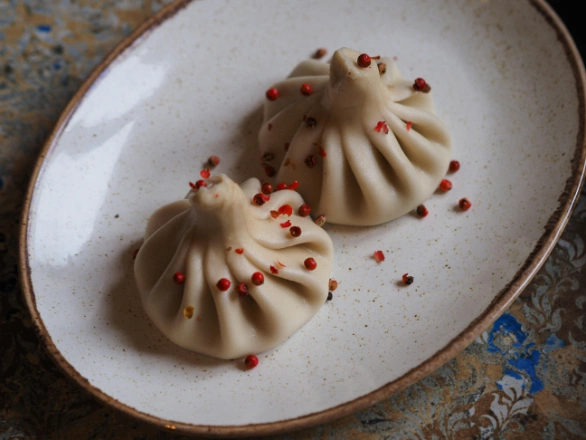
From Highlands to Heart of Georgia
Khinkali is believed to have originated in the mountainous regions of Pshavi, Khevsureti, and Mtiuleti, where shepherds and warriors needed hearty, portable meals. Stuffed with spiced meat, herbs, and broth, these dumplings provided warmth and strength against the harsh mountain winters. Over time, the recipe spread across Georgia, with every region adding its own twist.
The Art of Eating Khinkali
Tradition says khinkali must be eaten with your hands — never with a fork! You hold the dumpling by its top knot, take a small bite, and sip the hot broth inside before finishing the rest. The doughy stem is usually left on the plate, a playful reminder of how many dumplings one has eaten.
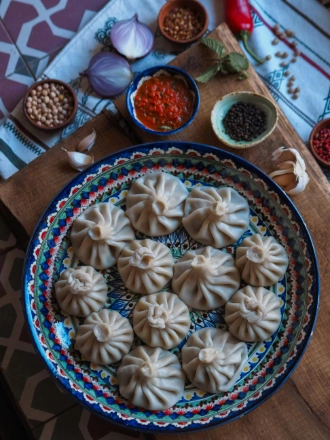
Khinkali Today
From Tbilisi’s busy taverns to family kitchens and fine restaurants, khinkali remains a star of Georgian cuisine. Modern variations include fillings with mushrooms, cheese, or potatoes, making them just as popular with vegetarians. Khinkali is also gaining global recognition, popping up on menus far beyond Georgia, where food lovers are discovering its unique charm.
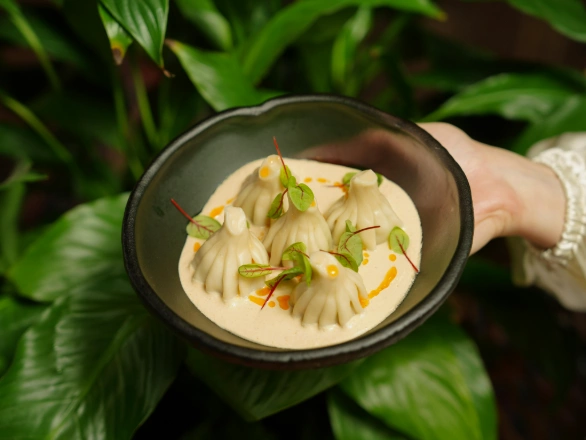
Tradition Meets Celebration
Khinkali is more than a dish — it’s a social experience. Gathered around tables, friends and families laugh, toast with wine, and count dumpling stems. It reflects Georgia’s larger tradition of supra, the feast, where food, song, and togetherness create unforgettable moments.
And in 2025, Georgia will once again share its culture with the world as Tbilisi hosts the Junior Eurovision Song Contest. Just like khinkali — humble, warm, and universally loved — the contest will bring people together, blending voices, stories, and traditions in one joyful celebration.
Votes: https://crowch.com/vote/2918/statistic/ https://crowch.com/vote/2919/statistic/
Autumn in Georgia is a season of abundance, when markets overflow with colorful fruits, and traditions of harvest bring families and neighbors together. With its fertile soil and unique climate, Georgia produces some of the juiciest, sweetest, and most diverse fruits in the region.

🌿 Key Autumn Fruits
🍇 Grapes — Star of the season, also used for winemaking during Rtveli (the grape harvest).
🍎 Apples & Pears — Crisp and aromatic; great for jams, compotes, and bakes.
🍑 Persimmons (Khurma) — Sweet, bright-orange fruit eaten fresh or dried.
🌰 Walnuts & Chestnuts — Essential to autumn sweets (e.g., churchkhela) and savory dishes.
🍐 Quince — Fragrant and perfect for jams and oven bakes.
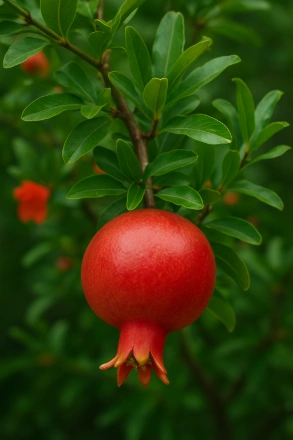
🎤 Why Autumn 2025 Is Extra Special: Junior Eurovision in Tbilisi
Georgia hosts the Junior Eurovision Song Contest 2025 in Tbilisi on Saturday, 13 December 2025—a huge cultural moment at the end of the autumn harvest. Georgia is also the most successful country in JESC history with four wins to date.
- Venue: Official announcements and government statements indicate the show will be held in the Small Hall of the Olympic (New Sports) Palace in Tbilisi.
- Local boost: The government has earmarked over €2.5 million to host the event—expect lively food markets, pop-up stands, and plenty of seasonal treats for visitors.
🍽️ What to taste if you’re in town for JESC
- Fresh persimmons, late-season grapes, and apple/pear varieties in markets across Tbilisi
- Churchkhela (walnuts dipped in grape must) and pelamushi (grape pudding)
- Walnut-forward sauces (like satsivi) and roasted chestnuts from street vendors
votes: https://crowch.com/vote/2919/statistic/ https://crowch.com/vote/2969/statistic/
Among the many delights of
Georgian cuisine, churckhela (often called the “Georgian Snickers”)
stands out as one of the most iconic and beloved. Strung nuts dipped in
thickened grape juice, hung to dry like candles, and cherished as both a sweet
treat and an energy booster—churckhela has been part of Georgia’s
cultural and culinary identity for centuries.
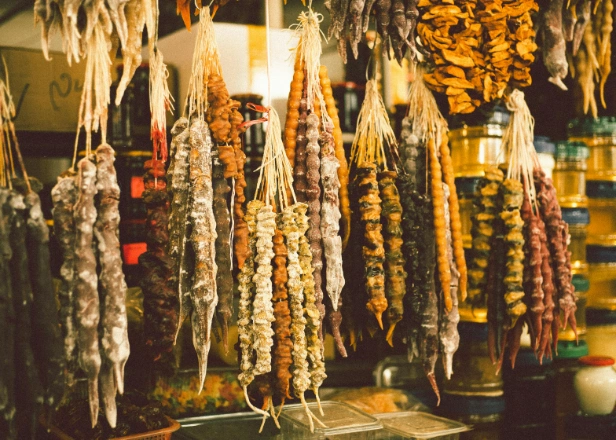
A Sweet History
Churckhela’s roots go back
to ancient times when warriors carried it on long campaigns. Its dense
nutrition and long shelf life made it the perfect travel companion.
Traditionally, walnuts, hazelnuts, or almonds are threaded onto a string, dipped
into tatara (a mixture of grape must and flour), and then dried until
a glossy, chewy coating forms.
This was more than just
food; it was a symbol of prosperity and abundance. Families prepared it in
autumn during the grape harvest (rtveli), ensuring sweets would last
through the cold winters.
Symbol of Celebration
Churckhela is a must-have
at Georgian feasts and New Year tables, often hanging in colorful bunches at
markets. Beyond its taste, it embodies Georgian hospitality—something shared
generously with guests. Its presence on festive tables reflects Georgia’s deep
link between food and joy, where every dish has a story.
From Past to Present
Even today, visitors
strolling through Tbilisi or Kutaisi markets are enchanted by rows of hanging churckhela,
like edible ornaments. Locals often say that to taste Georgia, one must taste
churckhela—it’s not just a dessert, it’s heritage wrapped in sweetness.
And as Georgia prepares to
welcome the world to Junior Eurovision 2025 in Tbilisi,
churckhela will no doubt be one of the flavors shared with international
guests—a delicious bite of culture, history, and Georgian pride.
When you think of Georgia,
wine may first come to mind—but for over a century, another drink has defined
daily life and warm memories: Georgian lemonade.
Its story begins in 1887,
when the pharmacist Mitrofan Lagidze in Kutaisi created fruit
syrups blended with sparkling mineral water. Known as Lagidze Waters,
these unique combinations of flavors—pear, tarragon, cream soda, and
more—quickly became beloved across the country. Unlike mass-produced sodas
elsewhere, Georgian lemonade was artisanal, rooted in natural ingredients, and
tied deeply to local culture.
A Cultural Icon Beyond
Wine
Georgian lemonade became a
symbol of hospitality, always present at family gatherings, feasts, and
childhood outings. Its unusual flavors—like the emerald-green tarragon or
golden pear—offered something distinct, making it both a nostalgic memory and a
proudly Georgian creation. For many, a chilled glass of lemonade is inseparable
from summers in Tbilisi, long countryside journeys, or bustling city cafés.

From Tradition to Today
Though wine remains
Georgia’s “liquid history,” lemonade has carved its own enduring legacy. Even
today, kiosks and shops across Tbilisi proudly sell bottles of the iconic
drink, reminding locals and visitors alike of the balance between tradition and
modern taste.
And just as lemonade unites
generations through a shared experience, so too will music connect people at
the Junior Eurovision 2025 in Tbilisi. With young voices from
across Europe gathering in the Georgian capital, the spirit of creativity,
tradition, and joy—much like in every glass of Georgian lemonade—will once
again be shared with the world.
Sources: https://www.instagram.com/natakhtari.uae/?utm_source=ig_embed&ig_rid=42a05853-f0c6-4411-a062-97a0d0f54755 https://sakartvelo.pro/en/georgian-lemonades/
votes: https://crowch.com/vote/2918/statistic/ https://crowch.com/vote/2919/statistic/
Nestled along the Georgian Military Highway, Pasanauri is more than just a mountain village—it is revered as the birthplace of Georgia’s most famous dish: khinkali. Known as the “mother of khinkali,” Pasanauri is where these juicy, spice-filled dumplings first emerged, feeding shepherds, warriors, and travelers making their way through the Caucasus.
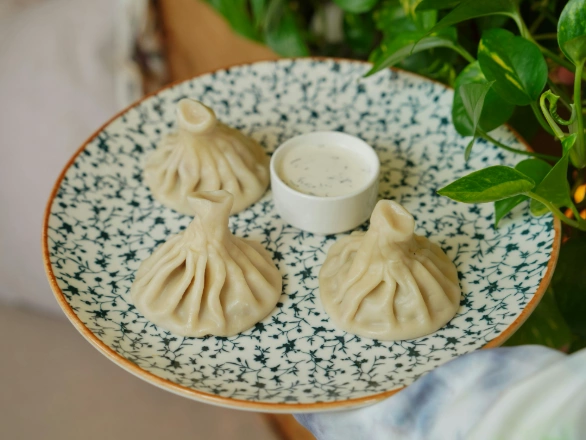
Khinkali here is unlike anywhere else. The dumplings are hand-crafted with precision, filled with spiced meat and broth, and twisted at the top into their signature knot. Locals say the authentic Pasanauri khinkali must be eaten the traditional way—picked up by hand, bitten carefully, and savored slowly so none of the rich broth escapes. This dish is not just food, but a symbol of Georgian hospitality, heritage, and pride.
A stop in Pasanauri also brings more than a culinary adventure. Surrounded by breathtaking mountains and the Aragvi River, the village offers a serene gateway to explore Georgia’s landscapes. For both locals and visitors, enjoying khinkali here is a ritual that connects the past to the present.
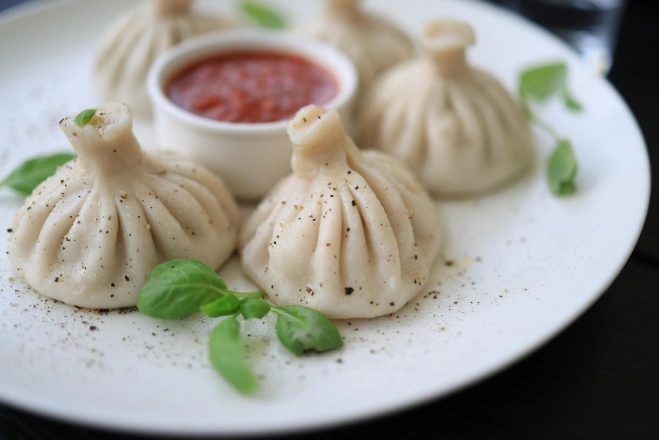
And just as Pasanauri continues to guard Georgia’s most beloved recipe, Tbilisi is preparing to showcase another side of the nation’s culture to the world. In 2025, Georgia’s capital will proudly host the Junior Eurovision Song Contest, blending tradition with modern creativity on an international stage. Together, khinkali and Eurovision remind us that Georgia is a place where heritage and innovation live side by side.
Votes: https://crowch.com/vote/2919/statistic/ https://crowch.com/vote/2918/statistic/
The origins of Nazuki stretch back centuries, especially in southern Georgia and the eastern region of Shida Kartli. Its very name, derived from ancient Persian, means “exquisite”, perfectly describing this fragrant, spiced bread. More than just a treat, Nazuki has long carried symbolic meaning. The ethnographer Tedo Sakhokia explained that it embodies prosperity, softness, and delicacy, qualities deeply woven into Georgian cultural values.

Nazuki holds a central place in Georgian celebrations, particularly in the regions of Kartli, Kakheti, and Meskheti, where it often appears as a ritual bread for Easter. Its sweet aroma, unique oval shape, and golden shine from the egg wash make it instantly recognizable at markets and family tables alike. Traditionally baked in a tone oven – a deep circular clay oven – Nazuki develops its distinct flavor and chewy texture. Yet even in modern kitchens, it thrives, baked in regular ovens while still carrying the charm of its ancient roots.
The recipe itself has variations, but key ingredients remain: milk, eggs, flour with good protein content, a touch of oil, spices like cinnamon and cloves, raisins, and just the right amount of sugar. Older Georgian cooking traditions once called for very sweet Nazuki, with up to 40% sugar in the dough, but today’s versions tend to be lighter, balancing sweetness with spiced warmth. Each loaf tells a story of community and continuity, a living bridge between generations.
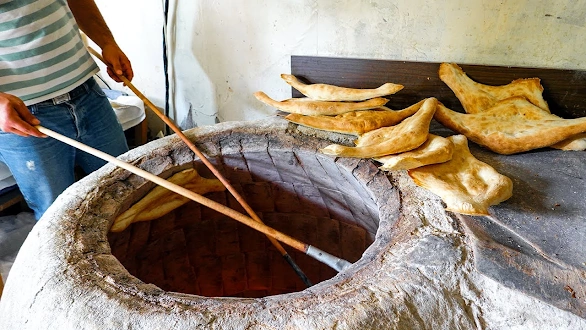
Interestingly, Nazuki also crosses borders. In Armenia, a bread of the same name is made, though quite different—prepared with filo dough and linked mainly to Easter traditions. This shared yet varied heritage underlines the cultural interconnectedness of the region.
In modern Georgia, Nazuki continues to flourish as both a nostalgic comfort and a culinary ambassador. Tourists often seek it out in Surami, a town famous for roadside vendors selling steaming loaves wrapped in paper. For many travelers, tasting Nazuki is as essential as visiting ancient monasteries or strolling through Tbilisi’s Old Town. And speaking of Tbilisi, the city is preparing to welcome the Junior Eurovision Song Contest 2025, a celebration of young voices and cultural pride. In a way, Nazuki and Eurovision share something in common: both are symbols of tradition meeting modern expression, cherished by locals while inviting the world to experience Georgia’s unique spirit.
Warm, spiced, and enduringly symbolic, Nazuki is not just bread—it is a piece of Georgia’s heart, baked into every festival, every family memory, and every journey across its storied land.
Sources: https://georgia.to/en/nazuki/#:~:text=Nazuki's%20roots%20in%20Georgian%20culture,to%20%22exquisite%22%20in%20Georgian. https://breadclub20.blogspot.com/2024/10/nazuki.html
votes: https://crowch.com/vote/2919/statistic/ https://crowch.com/vote/2918/statistic/
A Taste of Georgian TraditionGeorgia’s cheese culture is as rich and diverse as its landscapes. From the highlands of Svaneti to the fertile valleys of Kakheti, Georgian cheese varieties have been crafted for centuries, combining local milk, traditional methods, and natural aging techniques.Popular Georgian Cheeses
Suluguni – A semi-hard, brined cheese with a slightly elastic texture, perfect for grilling or baking.

Imeruli – Soft, mild, and slightly salty, commonly used in traditional pies (khachapuri).
Guda – Sheep’s milk cheese aged in sheepskin, with a distinct smoky, tangy flavor from the highlands of Eastern Georgia.

Tenili – A rare, stretched-curd cheese, aged in linen, known for its delicate texture and nutty aroma.Cheese in Daily Life and Cuisine
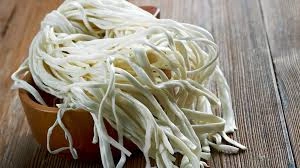
Georgian cheese is integral to the supra (traditional feast), served alongside bread, wine, and fresh herbs. It’s not just a side dish but a cultural expression, reflecting regional identities and centuries-old culinary practices.
Tbilisi will host the Junior Eurovision Song Contest in December, adding a festive, international flair to the city’s already vibrant cultural scene (junioreurovision.tv). Votes: https://crowch.com/vote/2918/statistic/ https://crowch.com/vote/2895/statistic/ https://crowch.com/vote/2919/statistic/
Sources: https://www.advantour.com/georgia/food/cheeses.htm , https://georgia.travel/types-of-georgian-cheese
Thanksgiving is one of the most important holidays in the United States and Canada. Its origins date back to the 17th century, when the Pilgrims from Europe arrived in the New World. In 1621, after their first successful harvest, they held a feast to express gratitude for the support of the Native Americans and for the bounty of the land. This tradition of giving thanks for harvest, life, and family has remained central to American culture ever since.

Today, Thanksgiving is celebrated on the fourth Thursday of November in the United States and on the second Monday of October in Canada. The heart of the holiday is the family dinner. A roasted turkey, mashed potatoes, cranberry sauce, vegetables, and pumpkin pie are the typical dishes served at the table. These foods are not only delicious but also symbolic of history and abundance.

Yet Thanksgiving is more than just food. It is a time when families gather, share stories, and strengthen their bonds. Many Americans also devote part of the day to charity, volunteering at shelters and donating food to those in need. Another major tradition is the Thanksgiving parades, with Macy’s Parade in New York City being the most famous. Millions watch the colorful floats, giant balloons, and musical performances.
In modern times, Thanksgiving has grown beyond its religious and agricultural roots. It has become a moment of reflection, when people pause to consider what they are grateful for and to appreciate family, friendship, and kindness. In today’s fast-paced world, Thanksgiving offers a rare chance to slow down and celebrate the true values of life.
If you come to Georgia hungry, you’ll leave with a full stomach and an even fuller heart. Georgian food isn’t just about taste — it’s about hospitality, history, and joy. From sizzling hot khachapuri straight out of the oven to churchkhela strung like candy necklaces in market stalls, every bite is a story of this ancient land.
And Tbilisi? It’s the country’s culinary capital, where old recipes meet modern creativity in some of the most exciting restaurants and cafés you’ll ever step into. Here are the spots every traveler should visit:
- Fabrika – A Soviet-era sewing factory turned cultural hub, now alive with art studios, bars, bakeries, and travelers. Perfect for bread fresh from the clay oven and wine with friends.
- Café Linville – Eclectic, colorful, and cozy. Think vintage furniture, patterned walls, and the charm of an old-world living room.
- Stamba Café – Brunch in a repurposed publishing house? Yes, please. Sleek design meets farm-to-table food in a sunlit courtyard.
- Lolita – Trendy, open-kitchen dining with a buzzing courtyard. A favorite for cocktails and casual yet stylish meals.
- Art-Café Home – A multi-level space filled with wild art, funky décor, and a rooftop terrace. Every room is a surprise.
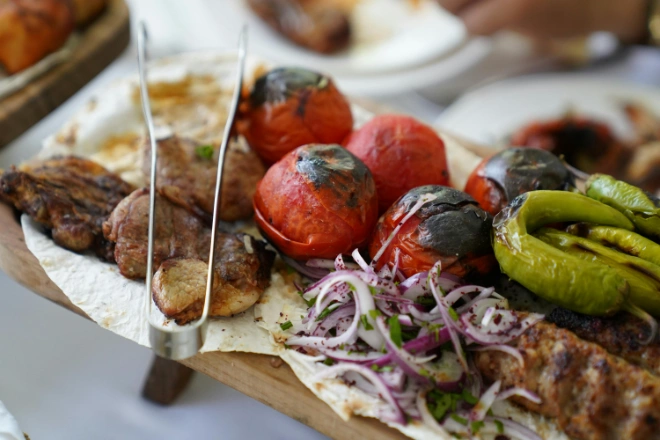
What to Try
- Khinkali – juicy dumplings filled with spiced meat.
- Khachapuri – the famous cheese-stuffed bread.
- Kubdari – a Svanetian bread stuffed with beef and spices.
- Pkhali – colorful vegetable pâtés for plant-based travelers.

Food, Culture & Celebration
Eating in Georgia feels like stepping into history — every supra (feast) is a gathering of stories, songs, and generosity. And just like its cuisine, Georgia’s culture is ready to be shared with the world. This December, Tbilisi will host the Junior Eurovision Song Contest 2025, bringing the same energy of togetherness that you’ll find around every Georgian tabS
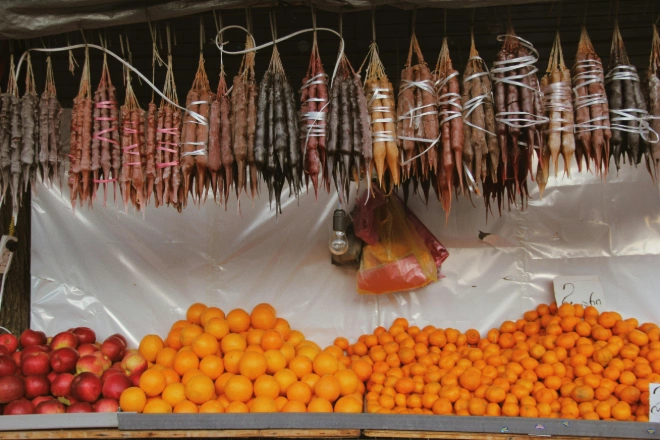
Votes: https://crowch.com/vote/2919/statistic/, https://crowch.com/vote/2895/statistic/ , https://crowch.com/vote/2918/statistic/
Sources: https://www.advantour.com/georgia/dishes.htm , https://wander-lush.org/tbilisi-georgia-food-best-restaurants-cafes-guide/, https://www.groovymashedpotatoes.com/7-uniquely-designed-cafes-restaurants-you-should-visit-in-tbilisi-georgia/